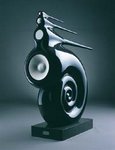Saturday, November 04, 2006
XBox 360 on my Sony Bravia High Definition TV
The XBox 360 Gaming Experience in High Definition: As soon as I hooked up the XBox 360 to my Sony HD TV and fired everything up, I was amazed by the clarity, colors and brightness of the panel. I connected my XBox 360 to the Sony HD TV using the HD AV component video cables that came with my XBox 360. I also used an optical digital cable (also called TOSLINK) to output the digital audio content to my Yamaha R-V1103 AV Receiver.
Note: The coaxial digital connection is superior to TOSLINK/Optical digital connection - and would have been my preferred connection, but it is not available on the XBox HD AV Pack
Since my previous TV as a non-HD TV, my XBox was originally configured for that TV. I got into the XBox Guide Menu and went to the System menu and changed the settings on the Console from standard TV to High Definition TV - as soon as I did that my picture went fuzzy and started doing strange stuff. That's when I remembered that the XBox connector had a small sliding switch at the bottom of the connector to switch between TV and HDTV. I changed the setting on my XBox connector and viola - the picture was phenomenally amazing!
I was really stunned by the clarity of the High Definition content. I also change the output setting from 480i to 1080i as this was the highest mode was supported by my TV (most LCD/Plasma TV's available in India right now do not accept 1080p signal). After that I shut down my XBox 360 and restarted it - the results were spectacular. The initial XBox 360 logo was displayed in HD clarity - the text on the screen had ultra-crisp edges - not a single jaggie - and super smooth - I was blown away.
I then popped in my Burnout Revenge game disk to check out the difference. Burnout Revenge can detect that your TV is set to HD mode and displays a special screen - EA High Definition Gaming - when in this mode. Once I started the game and got playing I notice the spectacular difference between playing games in standard definition and high definition. The colors were vivid, the details very clear, you could see every single detail so clearly that it was amazing! It was truly like 'looking out of a window' experience that most HD owners experience.
One of the main problems, that I found during my research, between LCD vs. Plasma specially for games and fast motion is the issue of motion blur which is a problem prevalent in LCD TV's. This is caused by the response time required by an LCD to change the image on the screen - the manual for my Sony Bravia LCD TV lists the response time of my TV at 8ms (milliseconds) which is the best an LCD TV can do at the time of writing (compare this with close to 0 ms for a CRT/Plasma TV). The response time can cause ghosting of images or motion blur for fast moving images specially in games - I am happy to report that there was no motion blur or ghosting that I was aware of during my gaming experience with Burnout Revenge, which has pretty quick action.
I tried another game - Perfect Dark Zero - and the results were stunning. There is a clear difference between the old standard definition (480i) and the new high definition (720p, 1080i, 1080p) resolutions that are simply amazing and once you see high definition content - you cannot accept anything else. Overall I am very happy with the results of mating my XBox 360 with my HD TV.
The XBox 360 as a DVD Player: I was curious to see how the XBox 360 would perform as a DVD Player. As reported previously, the XBox DVD Player sold in India is a region 5 player and will only play PAL content - it cannot play any other region (except universal or all region) discs. This was obviously a big disappointment, but I learnt to live with it. The XBox 360 does its DVD decoding and de-interlacing using the on board 500MHz ATI graphics processor. I also found after a little research that the XBox does not use all 3 cores in the IBM PowerPC CPU while playing the DVD player and some of them shut down during DVD playback.
The XBox DVD Player has the capability to output at 480i, 480p, 720p and 1080i (the 1080p will be provided as a software upgrade as per Microsoft press release). The XBox 360 games are output in all the formats upto 1080i assuming it is supported by the game. However, and this is a real bummer, the DVD Player only upscales DVD's to 480p thats it - period! No 720p or 1080i upscaling - what a let down! But considering the overall price of the Xbox 360, on which Microsoft is actually losing money, and considering what all it offers, it makes sense from a business perspective I guess. It would have been nice if the XBox 360 also came in a Premium Premium Pack that allowed the DVD Player to output at the highest supported resolution. So this is one thing to be aware of.
The media remote that comes with the XBox 360 Premium Pack is small, simple and uncluttered and does the basic job well. The load times of the DVD player are good and the menu's are intuitive and easy to use. The other nice feature I like is that the XBox remembers where you last left off and restarts the DVD at the correct point once you turn it on again. This is a real nice feature and very convenient - I really like it.
I popped in the 'Assault on Precinct DVD' to check out the difference. I really liked the images in terms of color and clarity. The lines were crisp and sharp and the black levels were very deep - none of the dark gray that you hear about in other LCD TVs - Sony obviously has done a great job with that. The fast moving action scenes were also great to watch with no obvious motion blur - the smoke, fog and snow rendered perfectly with excellent clarity. A lot of scenes in this movie have dark scenes with a lot of shadows, the DVD player and the TV performed very well in this area also and I was not at all disappointed. Compared to my old Sony Sony DVP-S500D DVD Player, I could see the difference in clarity and sharpness that was the difference between the 480i of my old player and the 480p of my XBox 360 DVD player which is a progressive scan DVD player.
Why LCD TV is a better choice than Plasma TV for XBox: Unlike a plasma TV, LCD TV's do not have a burn-in or image retention (IR) problem which is usually caused by static images in games (the score bar or other static images on the screen) as well as by static content on TV (ticker tape running at the bottom of the TV). In a plasma TV, the static images can cause the phosphors in that area to burn unevenly causing a image retention (which is not as severe as burn in) which manifests as a faint image of the static image even after the TV is switched off and then on again. Image retention is not so serious and goes away after some time. Burn-in is a more severe problem that causes the phosphors in the static image area to burn in - and this does not go away after a while and is more permanent in nature. Of course the technology is getting better all the time, with pixel shifting and other solutions for these problems in Plasma TV's, but I just didn't want to take any chances. This was the main reason that I opted for the LCD TV over the Plasma TV in the first place as I knew I would be playing a lot of games.
Resources:
XBox DVD Player Review
Microsoft Support - How to connect an Xbox 360 console to a TV by using the Component HD AV Cable
Monday, October 30, 2006
My Home Theatre System - Part II
The second part of this series describes the speaker configuration in my home theater system. As described in the first part, the speakers are driven by the eminently capable Yamaha R-V1103 multi-channel receiver. The speakers play a key role in the home theater system as they are ultimately responsible for sound delivery where the 'rubber hits the road' so to speak.
Front Speakers: My main front speakers are the Infinity Compositions Overture OVTR1 series of speakers. The Overtures are a 3 way full range set of speakers with an active side firing woofer - which means that these speakers need to be externally powered to drive the bass. Covering a frequency range of 35~20,000 Hz with a sensitivity of 92 dB at 1m/2.83 V with an 8 ohms impedance, the speakers do a great job of filling the room with clear crisp sound.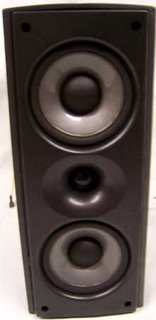
The 3 drivers that make up the speaker are:
Low Frequency: One 8" (200 mm) high efficiency, ultra-linear long throw magnetically shielded woofer.
Mid Frequency: Two 4" (100 mm) high efficiency, magnetically shielded mid-range drivers
High Frequency: One 1" (25mm) soft dome high efficiency, neodymium magnet, magnetically shielded tweeter
Specifications:
Amplifier Requirements: 10-100W @ 8 ohms
Crossover Frequencies: 300 and 3000 Hz
Peak Output: 250VA
Power Consumption: 150W (max), 7W (standby)
Width x Height x Depth: 5 3/4" x 12 1/2" x 12 1/2"
Weight: 13 kg
The Overtures are mounted on speaker stands that also come from Infinity and look pretty cool.
Center Channel: My center channel is the Infinity CC3 which is a low profile speaker system with two low and mid range drivers and a tweeter for high frequencies. This speaker has a frequency range of 80 ~ 20,000 Hz with the same sensitivity as the Overtures (91 dB @ 2.83 V and 1 m).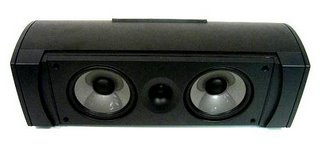
The drivers in this speaker are:
Low/Mid Frequency: 2 x 51 ⁄4" (125 mm) high-efficiency, ultra linear, long-throw, magnetically-shielded drive units
High Frequency: 1" (25 mm) soft dome, high-efficiency,neodymium magnet, magnetically shielded tweeter
Crossover Frequency: 2,500 Hz
The maximum peak output is 111 dB with an impedance of 8 ohms. The accompanying speaker stand allows a vertical tilt range of 25 degrees for ideal sound coverage whether placed on top of or below the television.
Rear Surrounds: My rear surrounds are the Infinity RS 5 floor standing speakers. These speakers feature Polypropylene Cones and Silk Dome Tweeters with co-injected woofer cones that are ideally suited for digital home theater sound. The Infinity RS-5 is a floor standing speaker with dual 6.5" drivers in D'applito configuration and a 1" soft dome tweeter.
Specifications:
Recommended Amplifier Power: 15-200W
Frequency Range: 35 ~ 20,000 Hz
Sensitivity (2.83V @ 1m): 92 dB spl
Nominal Impendence: 8 ohms
Bass: Dual 6 1/2" (160 mm)
High Frequency: 1" (25 mm) tweeter
Height, Width, Depth: 40 x 7 1/2 x 12 1/2"
Weight: 18 kgs
Active Sub Woofer: My home theater speaker system round up is completed by the Sony SA-WM40 - which is an active powered sub woofer with a 12" long throw driver in a bass-reflex (vented) cabinet. An onboard amplifier delivers 120 watts of power to the driver. The SA-WM40 sports both line-level and speaker-level inputs, as well as a line output for connection to additional subwoofers for even more bass. The crossover is variable from 50 Hz-170 Hz. This will help you to match this sub to the bass characteristics of your main speakers. The phase switch allows you to correct any phase conflict that may occur between the sub and your satellite speakers.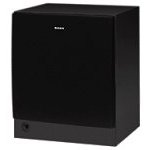
Specifications:
Type: Active Sub-Woofer (magnetically shielded design)
Speaker Unit: Woofer 30 cm diameter (12") cone type
Continuous RMS output: 120W
Reproduction Frequency Range: 20Hz to 170 Hz
High Feequency-Cut Off Frequency: 50Hz to 170 Hz
Phase Selector: Normal, Reverse
Input Jacks: Line Out (input jack pin)
Speaker Out: (output terminals)
Power Requirements: 120V AC, 60 Hz
Sunday, October 29, 2006
My Home Theatre System - Part I
Home Theater System Components
TV: The Sony Trinitron 32" KV-32V40 is the center piece of my home theater system. I purchased this system for around $800 in the US around 10 years back. Trust me when I say that it was a lot of money at that time for a TV. This is a CRT TV with a 32" diagonal screen with speakers in a thin strip on either side. It has an extra set of composite inputs on the front for hooking up a gaming console or other video sources. The back of the TV has the main set of connectors: 1 x S-Video, 2 x Composite/Audio In and 1 x Audio Out.
Since I purchased this TV in the US, it has an NTSC tuner which is useless in India - so I cannot view cable TV directly on this TV - I have to first run it through my computer via a TV tuner card and then into my TV via the S-Video or Composite inputs. I tried purchasing an external tuner in Pune, but they just weren't upto the mark in terms of performance or picture quality.
Update: I finally found another way to make my NTSC TV work in India.
The other thing to note is that this is a 110V TV - which means I also need a step down transformer with adequate power ratings to convert 230V AC to 110V AC. The maximum power consumption of this unit is 180W - but given the other equipment that I have - I thought it safe to get a beefy 1000 W step down transformer to power all my 110V equipment.
The things I like about the TV are the reliability, good picture and color reproduction and simple styling. The things I think could have been done better are: more connectors - that's right - the TV has just one S-Video connector - considered state of the art at the time I purchased the TV. So it is a real pain for me to keep switching the S-Video between my XBox and my DVD Player - but I have learnt to live with this and now I am very adept at switching the S-Video cables using just my fingers to feel the outline of the connector slot at the back of the TV. But this is not an issue if you plan to use the composite connectors as there are plenty available on the front/rear of the TV. The TV also weighs in at 70 kgs - which means its a real heavy piece of equipment - but also very sturdy because it made is across the oceans in a container when I moved from the US to India and also survived the local transportation when I moved houses in Pune.
DVD Player: I purchased my Sony DVP-S500D DVD Player for about $500 about 8 years ago in the US. This was one of the first DVD players to hit the market - and naturally as an early adopter I was the first to purchase it regardless of the then steep price.
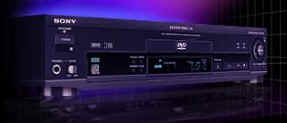
This player plans standard DVD's, music CD's and VCD's - but no MP3 because the technology wasn't prevalent at that time. The player also features 5.1 Dolby Digital output - which was a cutting edge technology at the time I purchased the player. In fact a sticker on the front of the DVD player screams - Dolby Digital 5.1 ch output. The players these days won't even mention this because this is now standard and taken for granted.
In terms of connectors, the player has a very good set of outputs including optical digital output and coaxial output for the 5.1 channel Dolby Digital audio output along with separate channel outputs for each of the 5.1 channels. The back panel also has composite, S-Video and component outputs for the video signal. The front panel includes a head phone jack for listening to music CD's with a line level adjuster.
This player is a region 1 player meaning that it will only play region 1 discs (US/NTSC) and of course All Region discs. I looked high and low for a firmware upgrade to override the region code setting but was unable to find it - so one main drawback of this player is that it will only play my US DVD's and Indian DVD's that are region free or universal.Since this was purchased in the US, this is also a 110V device - however the power consumption is very less compared to the TV - clocking in at a miniscule 22 Watts of power. This DVD player does not need a beefy step down transformer and will work just fine on a simple 50 Watt step down transformer that you can purchase at the local electrical store.
You can also select between 4:3 Letter Box, 4:3 Pan Scan and 16:9 aspect output for the video signal depending on whether you are connecting the player to a normal 4:3 aspect TV or a high definition 16:9 aspect plasma or LCD TV. Overall I love this player - I have had it for a while now and it has done a great job rendering high quality pictures on my TV. The dual discrete optical pickup with 96kHz 24 bit D/A converter does a phenomenal job in decoding the digital video and audio information encoded on the DVD and streams it in glorious color and detail into my TV and send a very high quality digital audio signal to my AV receiver to decode and amplify and drive my speakers.
Multi-channel audio receiver: The powerhorse of my home theater system is the Yamaha R-V1103 Natural Sound AV Receiver which I purchased for around $800 about 8 years back in the US. This receiver pumps out a beefy 100W per channel for each of the 5 channels in the 5.1 channel system. The receiver incorporates a Dolby Pro Logic Surround decoder along with a Dolby Digital (AC-3) decoder for multi channel sound reproduction. Yamaha is also known for its DSP (Digital Sound Processing) and the receiver comes with 10 DSP modes with settings for Rock Concert, Jazz Stadium, Church, Disco, Stadium, TV Sports, Movie Theater and Hall. To be honest, I am not a big fan of the DSP modes and I can hardly distinguish between these different modes and don't really use them that much.

The key specification for which I purchased this receiver is of course the Dolby Digital AC-3 decoder which provides completely independent multi-channel audio - with five full range channels in what is referred to as 3/2 configuration - 3 front channels (left, center, right) and 2 rear channels (left and right). A sixth bass only channel is also provided for output of LFE (Low Frequency Effect) - this channel is counted as 0.1 - giving a total of 5.1 channels. This allows precise sound orientation and gives rise to clarity in the sound signal that is unprecedented - you can hear effects like bullet casings hitting the floor behind you in a gun battle scene, or the screaming wail of a Formula 1 car as it blazes around the track. This is a truly immersive sound field and has to be experienced to be believed. Believe me, once you have experienced Dolby Digital sound in your home, you will never want to go back to the older Dolby Pro Logic sound.
The Yahama receiver comes with a plethora of connectors to satisfy every device that can be connected to it. It has an RCA type input each for Phono, CD, Tape, DVD/LD, TV/DBS, VCR (in/out). In the digital audio section, it has 1 x optical digital output and 2 x coaxial digital outputs. It also features separate RCA outputs for each of the 5.1 channels. In addition, it also has a video output section with 3 x S-Video connectors - of which one is a monitor out and the other two being S-Video in and out respectively. There are also 5 x composite video connectors with 1 monitor out, 2 reserved for DVD/LD and TV/DBS and 1 pair of VCR in/out composite connectors. The front panel of the receiver also has an S-Video input and 1 x composite audio and video inputs for easy connection of a gaming console or camcorder. Again as usual I find the connectors inadequate and would have loved to have an additional optical digital output and a digital coaxial output along with an additional S-Video input - I don't mean to sound greedy - but I really need these additional connectors to avoid constantly fiddling with the back panel of the receiver.
There are also speaker terminals on the back panel to connect the 5.1 channel speakers - left front, center, right front, left rear surround and right rear surround. The receiver also supports two sets of speakers for the front left, center and right - referred to as A/B speakers - you can connect upto 2 front left speakers, 2 front right speakers and 2 center speakers if you so wish. There is a switch on the front panel of the receiver that allows you to select between the A, B or both AB speakers.The receiver also features main channel line level outputs for driving speakers with an external amplifier - so if you want the Yahama receiver to decode the signal using the onboard Dolby Digital decoder but want the amplification to be done by a dedicated amplifier, then the main channel line level outputs can be used to feed the line levels directly to the amplifier which will in turn drive the speakers. In this case you will be primarily using the AV Receiver as a Dolby Digital Decoder and using another external amplifier to amplify the sound source and drive the speakers.
This configuration makes sense if you have a really good dedicated amplifier and want to squeeze that extra level of detail from the sound - for most home theaters this is an overkill. the only decive you would connect to the line level output of the receiver would be the sub-woofer, as this device has an inbuilt amplifier to amplify the line level input signal.The receiver also has a built in AM/FM tuner with an AM antenna loop that comes in the box which can be hooked up to the rear panel to receive AM/FM broadcasts. You can also connect an indoor FM antenna or an external outdoor FM antenna for better FM reception.
The silver remote that comes with this unit is a masterpiece in itself. It is a learning remote meaning that you can program it to control all your home theater devices like DVD Player, CD Changer and Tape Deck. It has a macro facility that allows you to do many operations with a single button press - for example - turn ON the TV, Receiver, DVD Player and press PLAY on the DVD player OR power down the TV, Receiver and DVD Player all with a single button click. The remote is backlit and has raised bumps along the buttons to easy control in the dark. The remote has a face-plate that can be opened up to reveal a whole bunch of other buttons that can perform virtually any operation you can think of.
CD Changer: My home theater also features a 110 CD changer from Yahama (no surprises there). The Yamaha CDM-900 110 Disc CD Changer holds all the CD's that I listen to and offers a convenient way to organize and group my CD's based on music type and style. It allows me to label each CD by artist and title and has the ability to display this information when the CD is playing. The really cool thing is that once you enter this information, the system remembers it and even if you change the CD position in the player, it is able to associate the CD with the artist/title information that you previously entered. It is this kind of intelligence that I really love - and I think small touches like this go a long way in making a good system an excellent system.

The CD changer has a front loading system with a front panel that swings down to reveal 110 CD's stacked vertically with the slot numbers labeled on the bottom face of the inside of the front panel. There is also a disc carriage loader that allows easy loading and unloading of CD's from their slots - but this is not really needed in day-day use. The remote that comes with the player has all kinds of buttons to do virtually anything you need sitting on your couch. The 110 CD's are organized as 5 groups - A,B,C,D and E. So for instance discs 1-20 are in Group A, discs 21-40 in Group B and so on. This allows you to categorize discs according to artist or music type and you can enjoy various play modes in each group. For instance you can select Group A and set it to random play or repeat plan - in which case discs 1-20 will be played in the selected play mode. This feature is quite useful if you have genres of music (rock, pop, jazz, new age, lounge) that you want to listen to as a group.
The CD changer also features a +1 disc - this is the first disk slot and is used if you want to listen to a CD and then remove it from the player. The +1 disc slot is usually kept empty for this purpose and allows you to quickly slip in a disc and listen to it without having to remember which empty slot you placed the disc in.Care has to be taken while moving the CD changer and if you need to transport it from one location to another, always remove the CD's from the changer before moving it. Otherwise, the CD's can fall into the player and you will have to unscrew the cover and get inside the player to remove the discs and restore order. I have done this a few times - the good part about the internal layout of the CD changer is that it is very well organized and uncluttered allowing you to work efficiently. I don't think I need to say that you need to make sure you unplug the device before attempting to open it - that's common sense isn't it?
Finally this is also a 110V/60 Hz system which I need to run on my step down transformer, however the power consumption is a measly 15Watt making this a good candidate for a smaller independent step down converter that you can purchase locally. Also this player can be chained to another CDM-900 CD Changer to have continuous play of 220 CD's if you so desire. The back panel of the CD changer has one optical output and 1 standard RCA phono jack for left right stereo sound output to an AV receiver. In my case, I have connected my CD changer to my AV receiver using the RCA phono jacks.As with all Yahama products, styling is very clean and uncluttered. The LCD panel on the front on the CD changer (and as with the AV receiver) is a cool orange - which looks really nice at night with all the lights switched off and has a charm of its own. The front of the panel also has a jog dial which you can rotate to change discs easily and is also used for entering artist/title text into the player. Overall I love my CD changer and have been very happy with it ever since I have owned it and highly recommend it if you are looking for one.
Twin Tape Deck: The twin tape deck also happens to be a Yamaha product - the K-903 Natural Sound Stereo Cassette Deck with auto reverse 4 track, 2 channel recording and playback. The tape deck comes with two decks - A and B with continuous relay play feature that allows you to play both sides of cassette A and B continuously in many different modes. It also has a Dolby Noise Reduction feature to eliminate hiss and noise during playback. The LCD screen on the front panel features a peak level meter in orange that looks quite cool and displays the peaks of the signal levels during playback or recording over a -30dB to +6 dB range. There are separate meters for each left and right channel.

The tape deck also has high speed dubbing function from Deck A to Deck B which allows you to quickly make copies of your casette tapes. The frequency response of the tape deck is between ~20-16000 Hz +/- 3 dB for Type I Normal tapes and this can go all the way to 20-19000 Hz +/- 3 dB for Type IV Metal tapes.
I hardly use the tape deck - and it is primarily used by my Dad to listen to and record his tapes. However as with the other Yamaha products, the build quality and finish is excellent and it has performed without any problems for over 6 years now - so I have no complaints and am very happy with this component.
Conclusion
This covers a round up of my home theatre system except for my speakers which I will cover in a second post. Hope you enjoyed reading this!
